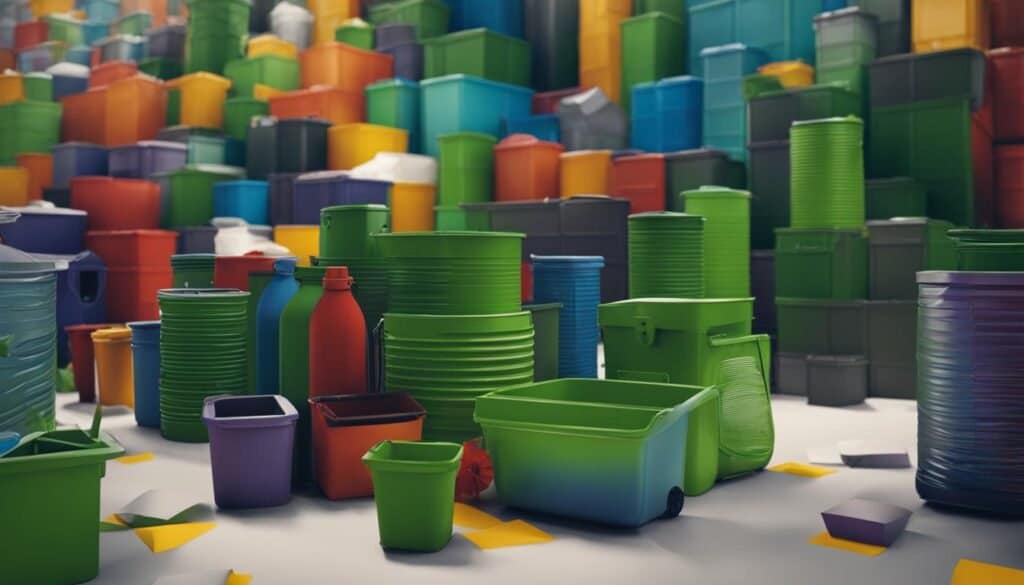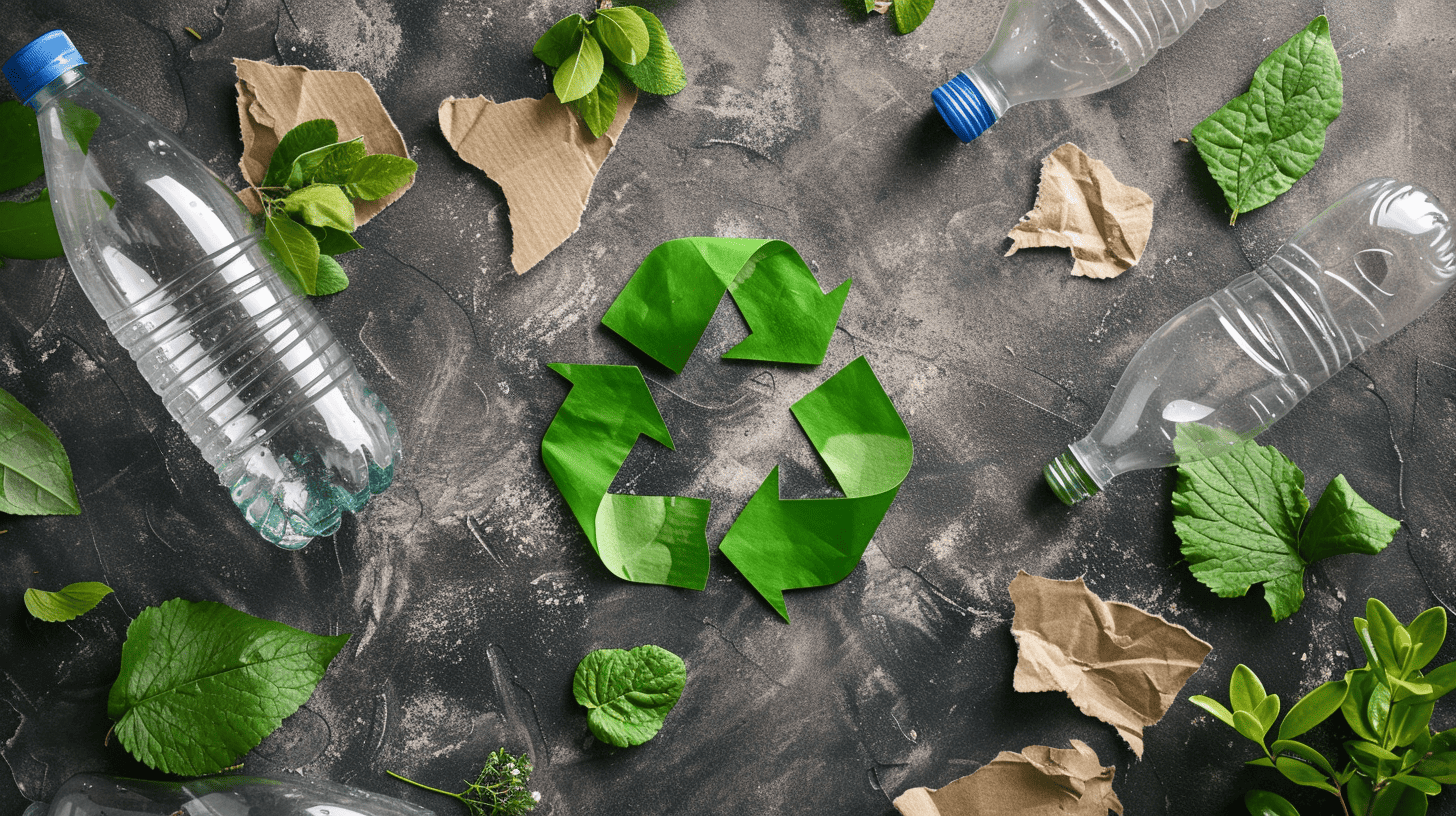As urbanization continues to expand at an unprecedented rate, the need for more sustainable waste management systems has never been more evident. A circular economy has emerged as the answer to our global waste challenges and plays a crucial role in sustainable development. By practicing resource conservation and focusing on waste reduction, the circular economy paves the way for an eco-revolution in how we manage waste and preserve the environment.
With the help of innovative approaches and by following the principles for waste management, we can reshape our consumption and production patterns into a cleaner, greener, and more resilient system. Join me as we explore the world of circular economy and waste reduction and how it revolutionizes the way we handle resources globally.
Key Takeaways
- The circular economy is an innovative approach to sustainable development, emphasizing waste reduction and resource conservation.
- Principles for waste management include recycling, reusing, reducing, repairing, refurbishing, recovering, and rethinking our consumption habits.
- Adopting a circular economy mindset in waste management can contribute to minimizing pollution, preserving natural resources, and fostering economic growth.
- Technology, such as the Internet of Things (IoT), plays a vital role in smart waste management, leading to more efficient resource utilization and waste reduction.
- Innovations in product design can lead to the elimination of waste at its source and help shape the future of a sustainable and circular economy.
The Vital Role of Smart Waste Management in Urban Growth
Urban growth has been accelerating at an unprecedented rate, posing significant challenges to current waste management practices and demanding more sustainable and efficient approaches. One of the most critical elements in addressing these challenges is the implementation of smart waste management, which boasts the ability to optimize resource use while simultaneously reducing waste. As a vital component of the circular economy, smart waste management has the potential to revolutionize the way we handle waste in our rapidly urbanizing cities.
Smart waste management leverages the power of technology to transform waste disposal processes, targeting enhanced resource optimization in sustainable cities. A pivotal aspect of this approach is the incorporation of intelligent systems and the Internet of Things (IoT), which enable waste management to become more dynamic through the utilization of data-driven solutions that enhance sustainability goals. IoT technology provides profound insights into waste generation patterns, allowing cities to implement sophisticated collection and sorting systems that work hand-in-hand with data analytics to responsibly and sustainably address consumption.
“Smart waste management is the future of sustainable cities, utilizing technology to streamline waste processes and ensure optimal resource allocation.”
The following table highlights some of the key technologies employed in smart waste management:
| Technology | Description |
|---|---|
| Smart sensors | Sensors attached to waste bins and dumpsters to monitor fill levels and provide real-time data on waste collection needs. |
| Route optimization software | Software that uses real-time data to determine the most efficient collection routes for waste management vehicles, minimizing fuel consumption and reducing emissions. |
| Smart waste sorting systems | Automated systems that utilize sensors, robotics, and artificial intelligence to sort and process waste materials for recycling or other forms of resource recovery. |
| Analytics for waste management policy | Data-driven decision-making tools and analytics platforms that inform policy decisions and evaluate the effectiveness of waste solutions across urban areas. |
In conclusion, smart waste management plays an indispensable role in handling the pressing challenges associated with rapid urban growth. By employing advanced technology in waste management, cities can enhance resource optimization, leading to more sustainable living spaces and waste solutions which contribute to the broader goals of the circular economy. As urban populations continue to expand, we must embrace the power of technology in waste management to foster a future where sustainability and growth go hand in hand.
Embracing the Circular Economy for Resource Protection and Economic Growth
The circular economy represents a transformative economic model that delivers both environmental preservation and significant economic growth by concentrating on three core principles: eliminating waste and pollution, efficiently circulating products and materials, and regenerating nature. In this section, we will explore these principles, the impact of extending product lifecycles, and the economic advantages of adopting a closed-life-cycle approach.
Understanding the Three Pillars of Circularity
At the heart of the circular economy are three primary goals often referred to as the pillars of circularity. Firstly, we aim to eliminate waste and pollution by designing products and processes that minimize or eradicate detrimental effects on the environment. Secondly, the focus is on efficiently circulating products and materials to keep them in use for the longest possible duration, reducing resource depletion and preserving value. Lastly, the emphasis lies on regenerating natural resources by enhancing natural systems, returning valuable nutrients to the earth, and promoting resource recovery through recycling and other innovative techniques.
The Seven Rs and Beyond: Extending Product Lifecycles
To achieve the goals of circularity, it is essential to adopt strategies that foster a culture of increased resource protection and waste prevention during product lifecycles. One such approach is practicing the Seven Rs: Recycle, Rethink, Reduce, Reuse, Repair, Refurbish, and Recover. These principles help extend product lifecycles, redefining consumption and production patterns while paving the way for a more sustainable future.
Economic Advantages of a Closed-Life-Cycle Approach
Embracing a circular economy not only contributes to environmental preservation but also presents numerous economic advantages. Adopting closed-life-cycle approaches can result in substantial business savings by reducing dependence on raw materials and encouraging innovation within goods, services, and business models that align with circular principles. Estimates suggest that employing circular economy strategies could generate up to $4.5 trillion in additional annual economic output by 2030, demonstrating the potential profitability of transitioning to sustainable practices.
Circular Economy and Waste Reduction in Action

As the movement towards a more circular economy gains momentum, smart waste management practices harness technology and innovative means to conquer waste reduction challenges. Notably, IoT enhancements have been making a significant impact on waste collection processes. In this section, we explore the central role of technology in shaping smart waste management practices and delve into the specific IoT enhancements transforming waste collection.
Technologies Shaping Smart Waste Management Practices
Technological advancements are driving the success of modern waste management infrastructure by providing data on waste volume, collection schedules, and locations to optimize processes and reduce inefficiencies. At the core of these initiatives lies the integration of Internet of Things (IoT) devices, which have revolutionized waste management through their real-time data tracking and forecasting abilities. The IoT-based solutions keep waste disposal in line with sustainability, eco-friendly values, and contribute to global circular economy efforts.
IoT Enhancements in Waste Collection
IoT devices have significantly advanced the landscape of waste collection, with innovative sensors and monitoring systems streamlining the entire process. By collecting valuable data on various aspects of waste disposal, these technological enhancements offer an array of benefits:
- Route Optimization: IoT-enabled waste management vehicles can devise optimized routes for waste collection, resulting in fuel savings and reduced emissions.
- Dynamic Scheduling: Real-time data on waste volumes allows waste management operators to adjust collection schedules according to actual needs, promoting efficiency and reliability.
- Consumer Engagement: Waste-related data can be made available to empower consumers, encouraging informed decisions about waste generation and disposal habits.
- Resource Allocation: IoT insights enable waste management professionals to allocate resources more effectively, directing them towards areas of higher waste output or urgent need.
These advantages lay the foundation for a comprehensive and robust waste management infrastructure, ensuring alignment with sustainability goals and contributing to the overarching vision of a circular economy approach.
Revolutionizing Waste Management with Smart Vehicles
Smart waste management vehicles are playing a pivotal role in revolutionizing waste management systems by increasing efficiency, reducing fuel consumption, and minimizing emissions. By incorporating advanced technologies like GPS, sensors, and real-time data, these smart vehicles are redefining waste collection while paving the way for a sustainable and regenerative urban infrastructure.
GPS Technology and Route Optimization in Smart Trucks
GPS technology has enabled route optimization for smart waste management vehicles, ensuring quicker and more efficient waste collection. Through data-driven insights, these vehicles follow the most effective routes, ultimately reducing fuel consumption and environmental impact. This optimization contributes to a sustainable waste management system that focuses on resource conservation and reduced pollution.
Increased Capacity for Waste Collection and Reduced Trips
The design of smart waste management vehicles accommodates increased waste collection capacity and higher efficiency. Due to their enhanced capacity, fewer trips to landfill sites are required, thereby reducing fuel consumption and greenhouse gas emissions. With the integration of smart technologies and efficient designs, these vehicles are significantly transforming waste management practices and leading us towards a truly sustainable and eco-friendly future.
Underpinning Sustainable Development with Circular Principles

The circular economy model serves as a vital foundation for sustainable development by emphasizing resource conservation and minimizing pollution. Incorporating principles that prioritize the longevity and efficient use of materials and products, sustainable development becomes a more achievable objective. Innovative recycling methods and the transition from linear to circular processes foster a thriving economy that benefits both the environment and economic growth.
As we shift toward a circular economic model, we can dramatically improve both our economic systems and natural environments. This demonstrates that a forward-thinking, sustainable approach to consumption and production is not only necessary but advantageous for all.
Several key factors contribute to the success of a circular economy model:
- Adhering to circular principles that minimize waste and support resource conservation
- Creating economic advantages through efficient waste management approaches
- Developing recycling innovations and embracing sustainable waste management methods
By following these principles, we can collectively achieve our sustainability goals and transform our economic systems into more resilient and eco-friendly models. In doing so, we can secure a more prosperous and sustainable future for generations to come.
The Design Imperative: Waste as a Design Flaw
Within the sphere of the circular economy, the significance of product design cannot be overstated, as it is at the design stage where we can address the flaw of waste. Innovative design approaches and technologies play a crucial role in eliminating waste and transitioning towards a more sustainable and circular economy. Let’s explore some noteworthy examples of innovative design advances in eliminating single-use plastics and revolutionizing textile manufacturing.
Innovative Design Eliminating Single-Use Plastics
Single-use plastics pose a significant threat to our environment due to their non-biodegradable nature and overconsumption. Several companies have been successful in developing innovative designs to eliminate single-use plastics and reduce excessive waste. One such company is Apeel, which has developed a plant-based coating that can be applied to fresh produce, extending its shelf life and reducing the need for single-use plastic packaging.
Waterless Dye Technology in Textile Manufacturing
Water pollution and excessive water use in textile manufacturing processes are well-documented problems within the industry. One innovative solution to this issue is DyeCoo’s waterless dye technology, which eliminates the need for wastewater in textile dyeing. This breakthrough technology utilizes supercritical CO2 to facilitate dye absorption into the fabric, significantly reducing water usage, while also eliminating wastewater and chemical discharge.
Companies like Apeel and DyeCoo are pioneering the design imperative and pushing the boundaries of what is possible in waste elimination. These innovative design solutions lay the groundwork for achieving a circular economy by preventing waste at its source and rethinking current production methods. As we continue to explore the immense potential of the circular economy, the importance of innovative design in waste elimination and resource efficiency cannot be overstated.
Why the Time for a Circular Economy is Now

As the global population continues to grow and resources become more scarce, the need to embrace a circular economy is more pressing than ever. The economic promise it offers, coupled with an emphasis on upstream design, ensures that transitioning to a circular economy is not only environmentally responsible but also economically advantageous. It’s time for businesses, policymakers, and individuals to make a paradigm shift and fulfill the potential of a more sustainable and prosperous future.
The Economic Promise of Up to $4.5 Trillion in Output by 2030
The circular economy holds the potential for substantial economic growth, with estimates suggesting an increase of up to $4.5 trillion in annual output by 2030. By embracing circular principles, we can unlock untapped value in the form of reduced waste, increased resource use efficiency, decreased dependency on primary resources, and opportunities for value creation in new markets and industries.
Emphasizing Upstream Design for Downstream Efficiency
One pivotal factor that drives the transition toward a circular economy is the importance of upstream design. Focusing on the early stages of production can have a significant impact on downstream efficiency, conserving resources, and minimizing waste. By implementing circular economy strategies like material loop closure and incorporating sustainable materials, product designers can create long-lasting, reusable, and recyclable products, paving the way for a more efficient and environmentally-friendly consumption model.
Now is the time to move toward a circular economy, where the economic and environmental benefits align perfectly. By harnessing the economic potential and focusing on innovative design, we can achieve a sustainable future in which resources are conserved, waste is minimized, and economic growth is fostered.
Integrating Sustainable Practices and Consumer Expectations
In today’s world, the integration of sustainable practices in modern business aligns with consumer expectations for ethical and eco-friendly products. Embracing circular economy adoption demonstrates a commitment to effective waste management and environmental stewardship, which resonates with contemporary consumers who consider their purchases as a form of activism. By acknowledging and meeting this demand, businesses not only foster brand loyalty and trust but also leverage the sustainable movement for economic success, consumer engagement, and market expansion.
Environmental education plays a vital role in raising awareness and reinforcing the importance of sustainable practices. As consumers become more knowledgeable about the impact of their actions and choices, they increasingly demand better and more sustainable alternatives. This growing consumer demand for sustainability has led many companies to reevaluate their business models and adapt their operations to meet these expectations.
“The greatest threat to our planet is the belief that someone else will save it.” – Robert Swan, Environmentalist
Furthermore, ethical branding that highlights a company’s commitment to sustainability, circular economy, and environmental responsibility has become increasingly attractive to consumers. Companies integrating best practices in resource efficiency and waste reduction are rewarded with loyal customers who value eco-consciousness in their purchasing decisions. This shift in consumer behavior presents a lucrative opportunity for businesses to remain competitive and thrive in today’s green-conscious market landscape.
- Offer eco-friendly product alternatives
- Reduce the environmental footprint of operations
- Incorporate sustainable materials in production
- Innovate in waste reduction and resource efficiency
- Engage in environmental philanthropy and activism
- Collaborate with other stakeholders in the circular economy
As the demand for sustainability continues to rise, forward-thinking businesses are taking meaningful steps to integrate sustainable practices and meet consumer expectations. Companies that adapt and evolve to cater to this shift in consumer behavior will reap the rewards of enhanced brand loyalty and a stronger market presence, ultimately contributing to a greener, more sustainable future for all.
Moving from Linear Models to Circularity in Waste Management
Transitioning from linear economic models to a circular economy represents a fundamental change in how societies view and manage waste. Embracing circularity in waste management entails adopting practices that encourage material circulation, resource resilience, and regeneration. As more companies implement circular strategies in their operations, they contribute to a regenerative economic system, achieving both environmental and economic sustainability goals.
Exemplary Companies Implementing Circular Strategies
Companies like Apeel and DyeCoo serve as stellar examples of businesses that have successfully integrated circular strategies into their operations. Apeel’s innovative, plant-based coatings extend the shelf life of produce, reducing food waste and the need for single-use plastics. On the other hand, DyeCoo’s cutting-edge waterless dye technology revolutionizes textile manufacturing by eliminating wastewater and other pollutants. By prioritizing sustainability, these companies demonstrate that circular economy models can also be economically viable.
“By adopting circular principles, such as material circulation and resource regeneration, firms can build supply chain resilience, promote ethical consumerism, spur innovation, and effectively contribute to a regenerative economic system.”
Building Resilience through Material Circulation and Regeneration
Material circulation and resource regeneration play a significant role in fostering resilience within an organization. Circular strategies emphasize the importance of utilizing resources effectively and efficiently by promoting reusing, recycling, and repurposing. By minimizing waste, companies can reduce production costs, lower their environmental impact, and meet sustainability goals.
- Reuse: Encourage product design that allows for multiple uses and extended lifecycles.
- Recycle: Implement practices to recover and process materials from discarded products, turning them into new ones.
- Repurpose: Find new functions and applications for used materials and products.
Moving towards the adoption of circular economy models can propel businesses into a more sustainable and eco-conscious future. By prioritizing environmentally friendly practices that prioritize circularity in waste management, companies can create lasting value while safeguarding the planet for generations to come.
Conclusion on Circular Economy and Waste Reduction
The shift towards a circular economy provides a promising and pragmatic solution for transforming waste management practices, effectively addressing global waste challenges. By redefining waste as a valuable resource, we can tap into the numerous benefits such an approach presents, ranging from environmental preservation and economic vitality to social well-being enhancement.
Central to this endeavor is the adoption of circular principles, which lay the foundation for producing goods in sync with nature, fostering a prosperous and sustainable economy, and promoting responsible consumption habits. Pioneering innovations and collaborative efforts are crucial as we progress steadily towards a regenerative and zero-waste society.
By embracing circular economy methodologies across various sectors, governments, and communities, we can join forces in building a more flourishing and sustainable future for generations to come. The moment is ripe for taking collective action and embarking on this pivotal journey towards lasting environmental stewardship and economic stability.
FAQ on Circular Economy Principles
Q: What are the principles of circular economy?
A: The principles of circular economy include eliminating waste and the continual use of resources, thereby minimizing the creation of waste and pollution.
Q: How does the circular economy approach plastic waste?
A: The circular economy approach to plastic waste focuses on reducing the consumption of plastic, reusing and recycling existing plastic materials, and designing products to be easily recyclable.
Q: What is the role of the Ellen MacArthur Foundation in waste management?
A: The Ellen MacArthur Foundation plays a key role in promoting the transition from a linear to a circular economy by advocating for sustainable resource use and waste reduction.
Q: How does the circular economy contribute to waste reduction?
A: The circular economy aims to keep products, components, and materials at their highest utility and value at all times, thus minimizing waste and promoting efficient resource use.
Q: What is meant by “life cycle” in the context of waste management and circular economy?
A: The life cycle refers to the stages through which a product or material passes, including extraction, production, use, and disposal, and considers the environmental impact at each stage.
Q: What is the approach to building a circular economy?
A: The approach to building a circular economy involves rethinking traditional linear models, prioritizing resource efficiency, and emphasizing sustainable practices throughout the supply chain.
Q: How does the circular economy aim to minimize food loss and waste?
A: The circular economy aims to optimize waste management, reduce food loss and waste, and redirect surplus food to value-added uses, contributing to a more sustainable food system.
Q: What are waste streams in the context of the circular economy?
A: Waste streams refer to the different types of waste materials generated in various stages of production, consumption, and disposal, which are targeted for management and reduction within the circular economy framework.
Q: What are some waste management strategies aligned with the circular economy?
A: Waste management strategies aligned with the circular economy focus on reusing and recycling materials, implementing sustainable production practices, and creating closed-loop systems to minimize waste generation.
Q: How does the circular economy aim to re-enter waste into the economy?
A: The circular economy aims to reintegrate waste materials and by-products back into the economy through innovative recycling, remanufacturing, and repurposing processes, thereby reducing the reliance on virgin materials.





Leave a Reply